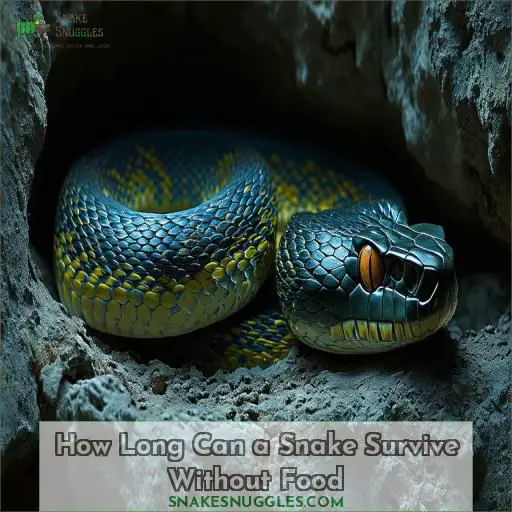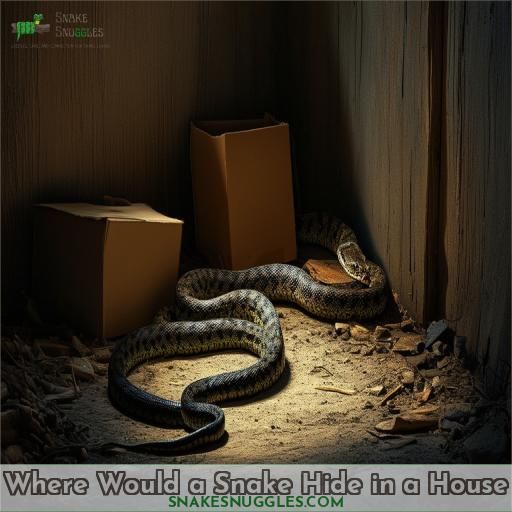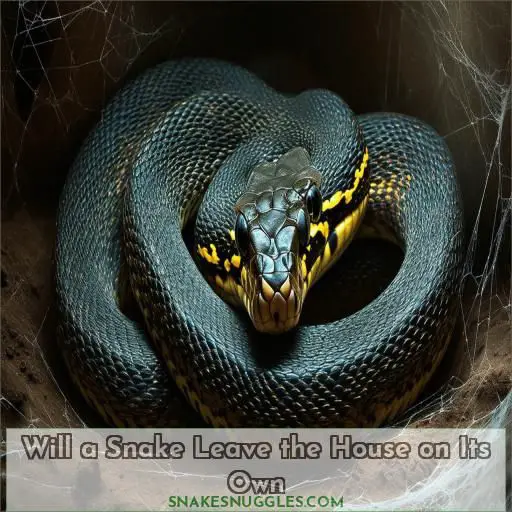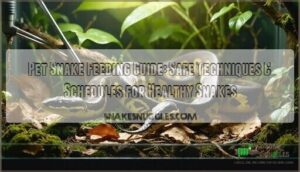This site is supported by our readers. We may earn a commission, at no cost to you, if you purchase through links.
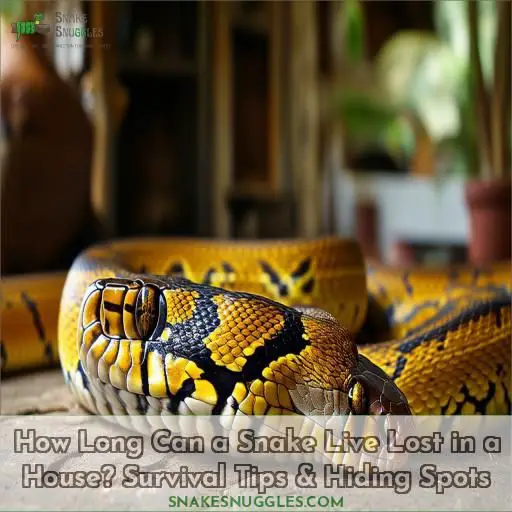 If a snake finds itself lost in your house, its survival depends heavily on how long it can last without food.
If a snake finds itself lost in your house, its survival depends heavily on how long it can last without food.
Most snakes can survive 4-5 weeks without eating, while larger species may endure 2+ months.
Their fat reserves aid survival, so younger, slimmer snakes require more frequent meals.
food availability is key – without rodents or insects to hunt, the snake’s chances diminish quickly.
Still, with some creativity and determination on your part, you can learn where these resourceful reptiles might be hiding and what steps to take next.
Table Of Contents
- Key Takeaways
- How Long Can a Snake Live Lost in a House?
- How Long Can a Snake Survive Without Food
- Where Would a Snake Hide in a House
- Will a Snake Leave the House on Its Own
- Frequently Asked Questions (FAQs)
- How long will a snake hide in a house?
- What to do if you lose your snake in your house?
- Where would a snake hide in a house?
- Will a snake leave your house on its own?
- Can a snake survive an entire winter inside a house?
- What attracts snakes to certain hiding spots?
- How far can a snake travel within a house?
- Do snakes make noise that can reveal their location?
- Conclusion
Key Takeaways
- These slippery serpents are surprisingly resilient houseguests – most can survive up to a couple of months without a morsel, thanks to their impressive fat reserves.
- If your scaly roommate has gone AWOL, don’t lose hope! With some snake-savvy sleuthing, you’re bound to uncover their cozy hideaway – maybe tucked behind the fridge, burrowed in a closet, or nestled in that forgotten shoebox.
- As tempting as it may be to fling open every door and window, your reptilian recluse likely prefers to stay put. These solitary souls tend to hunker down rather than risk a daring escape.
- While snakes don’t exactly make a ruckus, a bit of rustling or scratching from inside the walls could be your cold-blooded companion’s calling card. So keep those ears perked, especially after nightfall when things quieten down – you might just hear the telltale signs of your scaly housemate!
How Long Can a Snake Live Lost in a House?
A snake can live for months without food, staying hidden inside a house. Hiding spots can be in dark, undisturbed areas like under furniture or inside walls (Source).
How Long Can a Snake Survive Without Food
You’re probably wondering how long your lost snake can survive without food.
The answer depends on several factors like the snake’s species, size, and age.
Generally, most snakes can go 4-5 weeks without eating, but some larger species can last 2 months or more.
The snake’s fat reserves play a key role – bigger snakes have more stored energy to burn.
Younger snakes need food more frequently than adults.
While snakes can survive surprisingly long periods without meals, their chances improve if mice or other food sources are available wherever they’re hiding.
With some luck, your slithery friend could endure until you locate their secret refuge.
Where Would a Snake Hide in a House
If your snake goes missing, it likely seeks a warm, tight hiding spot. Here are some common areas to check:
- Behind and underneath large appliances like refrigerators and ovens
- Inside cabinets, drawers, and closets – snakes love dark, enclosed spaces
- Between baseboards and walls, or under floors if there are gaps
- Inside boxes, shoes, or other cluttered areas
- Burrowed under furniture cushions or bedding
Snakes are excellent escape artists, so diligently inspect every nook and cranny. Their hiding habits depend on the species, temperature needs, and available food sources. With patience and a keen eye, you can locate your slithery companion before it finds an escape route.
Will a Snake Leave the House on Its Own
You might wonder if your lost snake will attempt to leave your house on its own. Generally, this is unlikely. Snakes:
- Prefer dark, secluded areas with tight spaces to hide
- Don’t actively seek exits unless threatened or in need of food/water
- Tend to remain within the same general vicinity where they went missing
However, taking precautions is wise. To prevent an unwanted escape:
- Seal any cracks or holes a snake could potentially squeeze through
- Keep doors closed to rooms you don’t need access to
- Be cautious when opening exterior doors to avoid an unintentional getaway
With some snake awareness and simple containment measures, your slithery friend will likely stay put until you locate their cozy new hiding spot inside your home.
Frequently Asked Questions (FAQs)
How long will a snake hide in a house?
Like a hidden treasure, a lost snake can live for months within a house’s walls if conditions permit. While survival hinges on its size and access to food sources like mice, these elusive reptiles are experts at lying low until discovered.
What to do if you lose your snake in your house?
Search thoroughly – snakes are skilled at hiding. Use heat lamps, lower temperatures, set scent traps. Remain patient; many snakes reappear months later, alive. Prevent future escapes through secure enclosures.
Where would a snake hide in a house?
Did you know snakes can survive months without food? They often hide near heat sources like baseboard heaters, inside appliances, or behind furniture. Check cozy, warm spots – you may find your slithery friend there!
Will a snake leave your house on its own?
Snakes are solitary and will stay hidden, so you’ll have to actively search. They won’t leave on their own – their survival instincts keep them sheltering in dark, warm spaces until the environment feels safe again.
Can a snake survive an entire winter inside a house?
Snakes can survive an entire winter indoors. With their slow metabolism and ability to go long periods without food, they’ll hunker down and wait for warmer weather. So keep searching those cozy nooks and crannies – your slithery roommate may still be around!
What attracts snakes to certain hiding spots?
Envision a cozy nook, a snake’s paradise – warmth, dark crevices, that irresistible mouse scent lure it in. You’ll find them where their survival instincts lead: safety, sustenance and just the right hideaway.
How far can a snake travel within a house?
Snakes can travel astonishingly far within a house, slithering through tiny crevices and exploring every nook. You’d be amazed at the distance they cover while invisibly traversing their newfound labyrinth.
Do snakes make noise that can reveal their location?
Snakes typically don’t make audible noises that help locate them. However, their movements against surfaces like pipes, floors, or walls can create subtle rustling or scratching sounds. Listening closely in quiet areas, especially at night, may reveal their presence if they’re hiding nearby.
Conclusion
Skillfully spotting slithery serpents‘ surreptitious hiding spots safeguards your sanctuary. Remember, resourceful reptiles can survive several weeks lost in a house without sustenance. Though tenacious, these transient trespassers typically tire and depart unaided. Vigilance and patience prove essential when a snake seeks sanctuary within your home’s walls.

